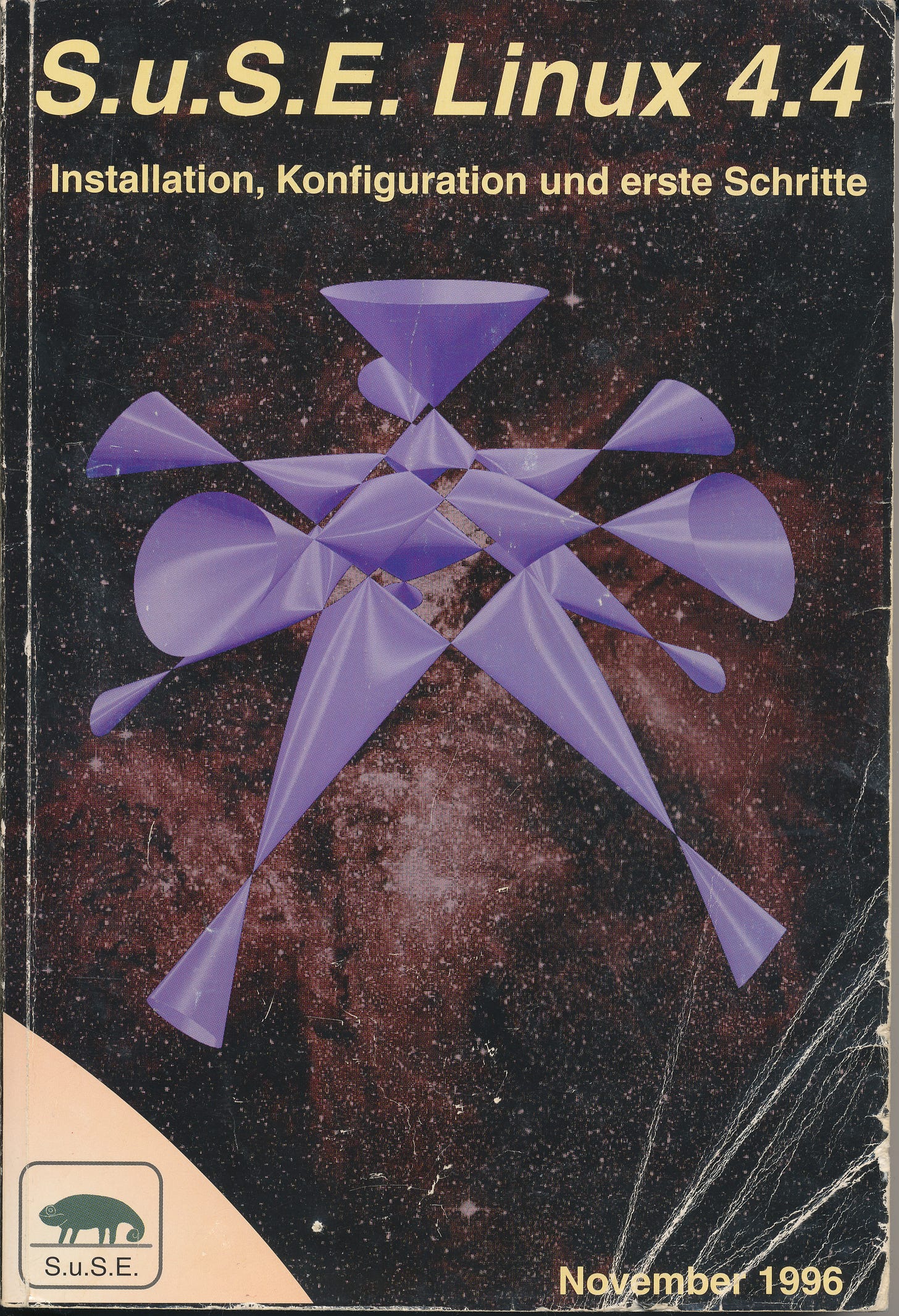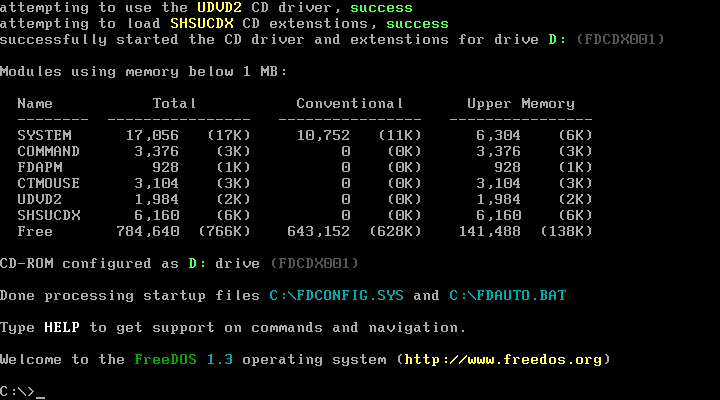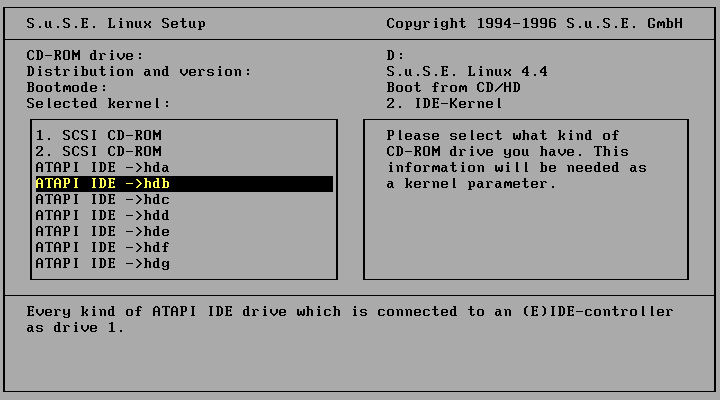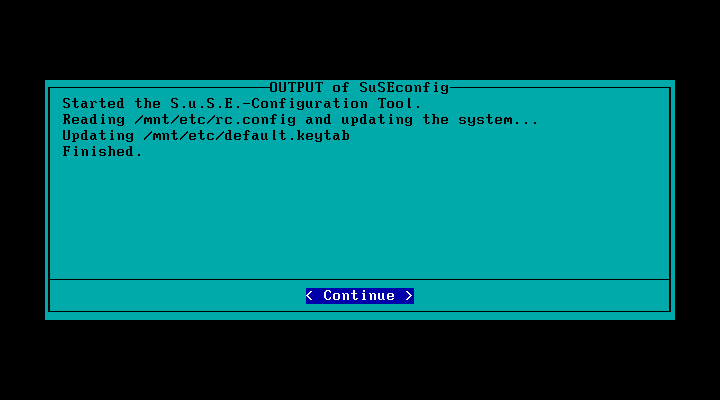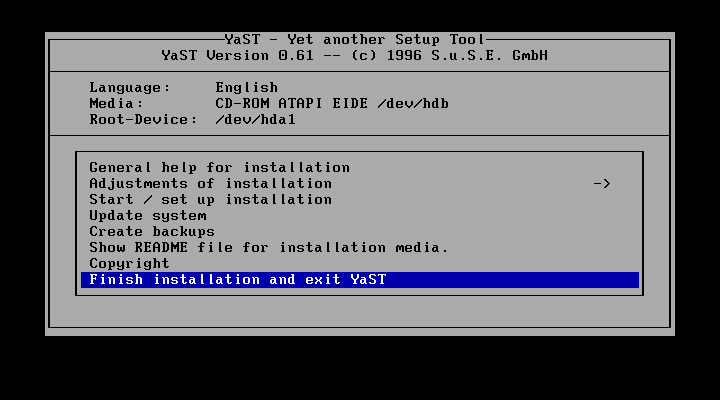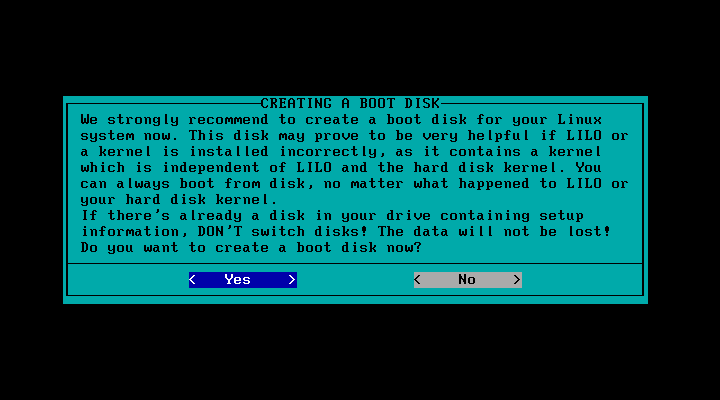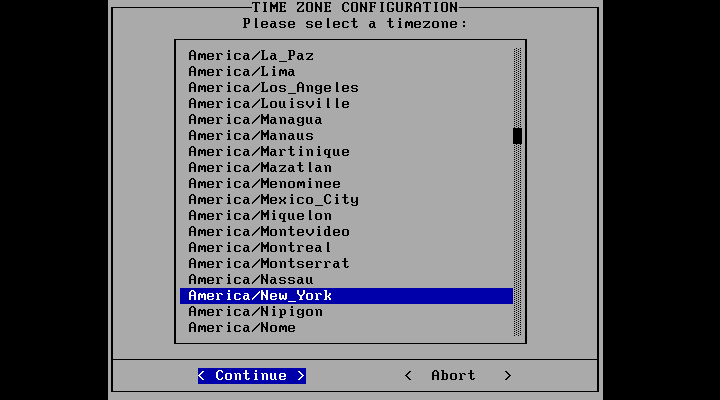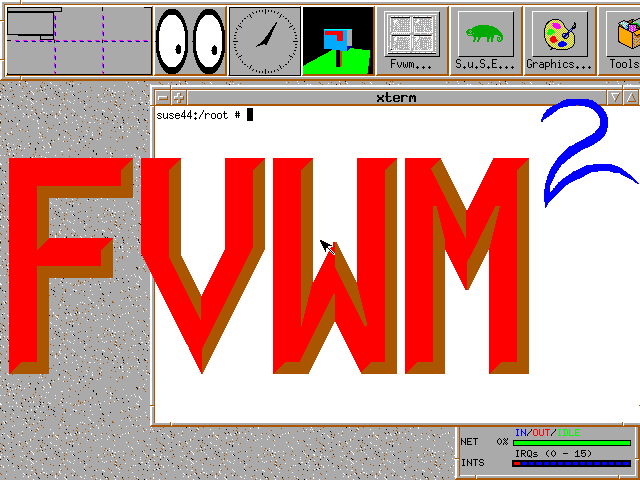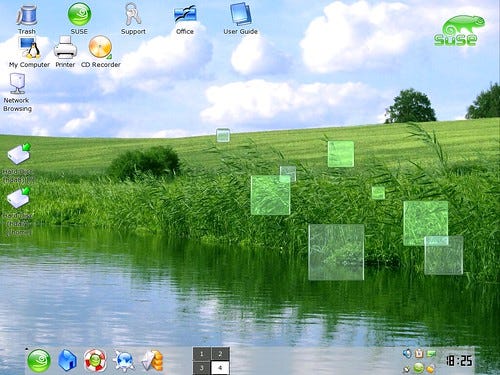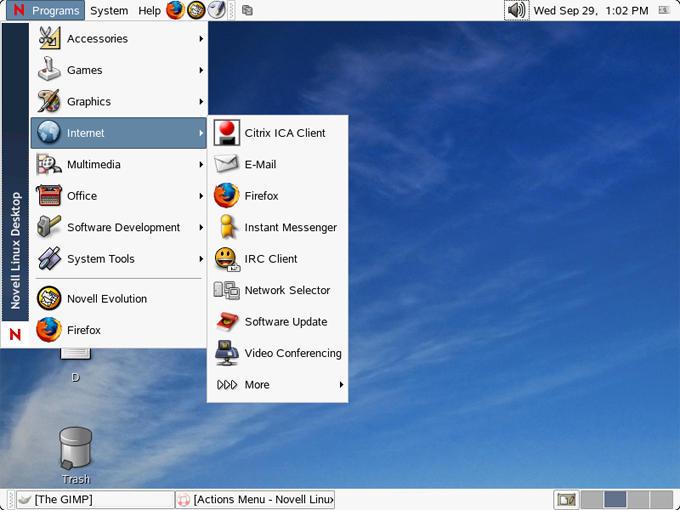The History of S.u.S.E.
The other enterprise Linux company
In 1992, four college students, Roland Dyroff, Thomas Fehr, Hubert Mantel, and Burchard Steinbild in Fürth, Germany were dreaming of independence. They wanted to chart their own paths, make money for themselves, and have fun doing so. They’d had significant exposure to UNIX at university, and there was a new, free, and open source kernel called Linux from Helsinki. At the same time, there was Peter MacDonald’s Linux distribution, the Softlanding System (SLS), and Patrick Volkerding was publishing fixes for SLS and making them freely available via FTP. Somewhat problematically, most UNIX systems and most Linux systems were exclusively English language oriented. These four students were ready to do something for themselves and they began the process of localizing SLS into German.
On the 2nd of September in 1992, the quartet founded Gesellschaft für Software und Systementwicklung mbH (or S.u.S.E.). In English that would be Software and System Development, but the contraction S.u.S.E. also bore more than a passing similarity to the name of Konrad Zuse who’d built the world’s first programmable and Turing-complete computer (depending upon how one defines this) the Z3 in May of 1941.
Shortly after they began, Patrick Volkerding released Slackware Linux. Their work then shifted to localizing Slackware, and they managed to obtain assistance in this endeavor from Volkerding. Of course, translations weren’t quite enough to get a company going. They chose to focus on localization, software development, distribution, documentation, and customer support. With the kind of energy seemingly available only to college students, they worked hundred hour weeks, and they sought no outside investment having opted to sell software CD-ROMs and floppies to fund their endeavor (via phone/mail and retail boxes). They were among the first resellers of Yggdrasil, and they also had their semi-localized versions of SLS and Slackware, along with patch sets. While this may not appear to be an obvious path to younger readers today, this was truly a huge service to their customers. The internet wasn’t widespread, and for those who had it, it was slow. Sure, one could download all forty Slackware floppy disk images, but it would take quite a bit of time on a 28.8kbps modem. Then, if someone in the household had needed to make a call, the download would have been interrupted. After that, one needed to have forty blank floppies available, and image each one, one at time. After what may have been intermittent work over the course of a few days, the potential Linux user was then greeted with a command line in a foreign language. The alternative was to call up S.u.S.E. with a number found in an advertisement in a trade magazine and get a CD-ROM for your 386/486 PC that had been localized to your own language. With that, you might also get a manual, again in your own language, that explained how the software system worked and what it was you might need to do to get things fully operational.
In these halcyon days, the young company had no real hierarchy, no regular meetings, no reports, and no bureaucracy. The company operated in a sort of democratic fashion. Being so small, everyone knew everything that was occurring at any given time. If a major decision needed to be made, they’d simply take an informal vote. If they had unanimity, they’d make the change and this meant that the company could change direction in a single night which was when they normally got the most work done.
In 1994, S.u.S.E released a fully localized version of Slackware Linux 2.0 with some patches and software incorporated from other Linux distributions, S.u.S.E. Linux 1.0. This release was quickly followed by 1.1.27 in July. This was a Linux system with the XFree86 2.1.1, TCP/IP, NFS, kernel 1.0.9, GNU CC 2.5.8 and 2.4.5, and documentation on disc. The system requirements were a 386 with at least 4MB of RAM, but if one intended to use X11 the RAM requirement was a minimum of 8MB. The system supported ISA, EISA, VLB, and PCI, but it did not support MCA.
The year prior, 1993, Florian La Roche had started Jurix. He began with writing patches for various UNIX and GNU packages to make them work on the Linux kernel, and he kept these separate from the vanilla sources. He then wrote a script that he placed at /usr/bin/pkgpack which would collect those patches and apply them prior to compilation. The distribution was shipped as a binary system on five floppy disks, and the first production installation was completed in 1994 at Saarland University for those studying law (Jura is “law” and “ix” is the common suffix for UNIX-like systems). This first install was online at jura.uni-sb.de and there were several client systems internally. The university used this system to make email, web, and other software available to students. La Roche joined S.u.S.E. in 1995.
With La Roche on the team, the company began work on their next major Linux release, but this time, the company was mixing in pieces of Jurix. From what I can tell, this was largely the build system. Slackware has used standardized bash scripts for package creation (these are now known as SlackBuilds), while Jurix had a system that would become AutoBuild, and much later the Open Build Service. Much like the purely Slackware-based S.u.S.E. Linux releases, this version would use a curses menu system for installation, and many users would boot to MS-DOS and then use LOADLIN to get into the Linux system. However, these similarities can be deceiving. The S.u.S.E. installer was for more polished and far more informative at each step. Version 4.2 (numbered for the answer to life the universe and everything) was released in May of 1996 with the Linux kernel 2.0 and YaST (yet another setup tool) 0.42. This release was on three CD-ROMs with one being the live filesystem and two for the installation. From DOS, the first install disc’s contents were as follows:
Most references of version 4.2 state that the distribution was only available in German, but this is incorrect. The initial boot configuration allows a choice of either English or German.
After the installation environment is loaded, when init handed off control to a tty, the user was greeted with a logon screen, again in both languages.
From there, YaST would take the user through the installation in a well design curses environment.
Version 4.4 was released in November of 1996. For this tour of S.u.S.E. 4’s installer and first boot, I am using a Pentium at 133MHz, 128MB of RAM, 2GB HDD (generic CF card adapter from Amazon), ATi VGA Wonder XL, SB16, and an NE2000 ISA (8bit RTL8019) network card. The machine has an internal 3.5 inch floppy disk drive and an IDE CD-ROM. This machine had FreeDOS 1.3 installed at the time of the S.u.S.E. installation.
At this point, the system was ready to load Linux.
After creating a Linux disk partition, the user is required to reboot (though nothing informs you of this). At that point, the partition changes are written to disk. In my case, this meant that I would need to boot from a floppy. There is an option to create a Linux boot floppy, but I chose to use a Win98 boot floppy instead. This essentially runs through the LOADLIN portion for a second time, after which I restarted the setup, loaded the config for all packages, and proceeded with the installation.
Here, selecting the main menu will allow the installer to progress to finishing the installation.
After login, there’s a brief delay and then we go through the first run setup procedures.
That took an incredibly long time on my modest 1990s system.
After login, I went ahead and did X86Setup.
With the X server configured, I could now run startx to enter the graphical environment, which was FVWM2. I didn’t feel like installing the X driver for my GPU, so what you see next is just VGA at 640 by 480 and doesn’t do the system justice. If you’ve seen FVWM2, however, then you’re not missing too much.
Of course, YaST was available for handling post-install setup if needed. Given the number of sources having stated that S.u.S.E. switched to RPM’s and Jurix at this point, I did some exploration. While it may have had many of its technologies from Jurix, and it may have deviated from Slackware in some ways, the package series and package management were still very much from Slackware, RPM was not present, and several packages seemed to be indistinguishable from Slackware such as aaa_base.
S.u.S.E. Linux version 5 was released in July of 1997, and that was the version to begin the transition of the distribution to RPMs. Slackware’s TGZs were still supported. That release used kernel 2.0.30, Bash 2.0, Qt 1.2, XFree86 3.3 and FVWM 4.0.45. October of that year saw the release of version 5.1 with the most notable changes being the support of FTP package updates and KDE. This version was five CD-ROMs. Four of these were for the installation, and one was for the LiveCD environment. The final version 5 release was on the 10th of September in 1998, version 5.3 with kernel 2.0.35, KDE 1.0, and Netscape Communicator version 4.05.
So, here in the installer, we can see a clear evolution from the prior release. Everything is a bit more refined, the installation was far more straight forward, and we can easily see that what has been reported as a complete rebase on Jurix, was truly more of a merger between the Slackware-rooted origin, and the RPM-based Jurix with its automatic build system. We can also see that S.u.S.E. was now evolving into something unique, something gestalt. That said, my installation on a K6-III crashed repeatedly.
S.u.S.E. opened a branch office in Oakland in 1997 as well as more offices across Europe. Not long after these expansions came new partnerships with IBM, SAP, Compaq, and Oracle. For IBM and Compaq, this partnership included S.u.S.E. offering 24-hour support services. The same year, SuSE began offering servers pre-installed with S.u.S.E. Linux. For 1998, the company moved their corporate office from Fürth to Nürnberg. In 1999, the company opened a branch office in the UK.
The company released version 6.0 on the 21st of December in 1998, and with this release, the company rebranded as SuSE Linux. Version 6 shipped with kernel 2.0.36, and it saw point release up to 6.4 which released on the 9th of March in 2000. Version 6.4 included YaST2 which was graphical.
On the 27th of September in 2000, SuSE Linux version 7 was released. SuSE Linux Professional 7.0 consisted of six CD-ROMs and one DVD for those who had a DVD-ROM drive, two floppies for those who couldn’t boot from optical media, a quick install guide, a handbook, a configuration guide, and an applications guide. By this point, like many other commercial Linux distributions, SuSE included StarOffice, Netscape, Acrobat, GIMP, Sane, KDE, and other familiar applications. It had a graphical YaST2 setup tool, ReiserFS and ext2 filesystems, RPM package management, and retailed for $69.99. SuSE Linux Personal lacked many of the proprietary applications and shipped on three CDs. This version saw released for x86, Alpha, PPC, and SPARC. The last of the version 7 systems was 7.3 released on the 23rd of October in 2001.
In the late 1990s, it was becoming obvious that Linux was going to be a major player in the operating system space, and IBM was well aware. The company had been engaging with open source projects like Apache and Linux for their Power and x86 systems, but the idea of running any non-IBM operating system on an IBM mainframe was heresy within the company. Yet, this was something that IBM’s leadership knew needed to happen. To that end, in December of 1998, IBM began a secret project to port Linux and the GNU C toolchain to the S/390 in Böblingen. At this time, the company had no plans to release a distribution of their own, but they hoped to offer a starting point for distribution makers. This effort was released in December of 1999. SuSE was the first company to do anything with this, and their effort would reshape SuSE. They approached IBM in early 2000 with a proof of concept for which they received an orientation on IBM mainframes and a reference system for software development. They used their AutoBuild system to generate packages resulting in 400 or so in the first weekend. They then ported YaST and continued refinements. A major shakeup for SuSE was that this version incorporated some things more similar to Red Hat than to Slackware, such as the directory hierarchy and some file naming conventions. The prior origins could still be seen, but things were a bit more nuanced. The more difficult task for SuSE was really learning about the enterprise market with its low-volume, high reliability, and service intensive nature. On the 31st of October in 2000, SuSE Linux Enterprise Server was born. Linux had come to IBM S/390. SLES for x86 followed in April of 2001, and ports continued for Itanium, PPC, and zSeries.
By November of 2000, something around 66% of SuSE’s revenues were from Linux CD-ROM sales at retail, online, over the phone. Roughly 24% was from services, and the remaining 8% or so was from hardware sales. The company had around forty developers working on open source software, and this didn’t include people who handled the compiling and packaging into RPMs (release engineers), or those who handled support services. Beyond this, the company contributed both money and talent to projects like ReiserFS, KDE, and the Linux kernel.
The recession of 2001 hit the company hard. First, thirty of the forty five employees at the Oakland office were laid off on the 8th of February in 2001, and the support services previously offered from that office were shifted to Germany. At this time, the company had grown to 470 employees, and they were one of the four major players in enterprise Linux globally (Red Hat, Caldera, Turbolinux, and a potential fifth, Mandrake fighting to make their entry). This move wasn’t quite unexpected. The US and German offices had never really worked together all too well, and the US office had seen four presidents in as many years. Later that year, Johannes Nussbickl took over the CEO role from Roland Dyroff. Nussbickl then went out attempting to secure venture funding, and slashed headcounts a bit further, about a quarter of all staff. Nussbickl was replaced by Richard Seibt the following year.
SuSE Linux 8.0 was released on the 22nd of April in 2002 with Linux kernel 2.4.18, KDE3, KOffice, and several other enhancements. The installer was more automated, had better hardware detection, and YaST2 could detect Windows partitions. Upon the detection of a Windows partition, the installer would suggest changes to hard disk allocation for the installation of SuSE. YaST2 was also much better at configuring the X server with SaX2 (SuSE advanced X configuration). On the media side of things, SuSE 8 included applications for audio mixing, editing, and CD writing. These audio applications were aided by the inclusion of ALSA 0.9 (Advanced Linux Sound Architecture) which allowed for the playback of more than one audio stream at a time. Security enhancements also came to SuSE with SuSE Personal Firewall 2, GNU Privacy Guard, OpenSSH, PAM, and IPsec. Version 8 concluded with the release of 8.2 on the 7th of April in 2003.
SuSE Linux 9.0 was released on the 15th of October in 2003 with Linux kernel 2.4.21, GNOME 2.2.3, and KDE 3.1.4. This version brought two major changes. First, SuSE Linux 9 was the first distribution to support AMD64. SuSE had reached out to AMD early in the Hammer architecture’s development, and they built an emulator from AMD’s specifications. The company then proceeded to port the entire distribution AMD64 with AutoBuild. When the first hardware arrived at their offices, the system worked flawlessly. The second big addition was support for NTFS (non-root) filesystems.
On the 13th of January in 2004, Novell announced that it had completed its acquisition of SuSE, now styled SUSE, for $210 million in cash. With this completed, IBM then invested $50 million in Novell. This followed Novell’s acquisition of Ximian in 2003. Ximian had developed Ximian Evolution (eMail client), Connector (plugin for Evolution offering MS Exchange support), Red Carpet (RPM-based package manager), Bonobo (MS OLE-like), and Mono (.NET framework for Linux). These acquisitions fundamentally changed Novell. The company’s prior focus on networking products was gone, and the company became, at its core, an enterprise Linux company. That is, it essentially became the SUSE company. For many at the company, this was actually a welcomed change. The company had been on the verge of insolvency for quite sometime, the lay offs were obviously horrible (not just for those who lost jobs, but also for the increased workload for those who remained), and this take over brought some breathing room.
The first release after acquisition was SUSE Linux 9.1 on the 23rd of April in 2004. This version shipped with kernel 2.6.4, GNOME 2.4, and KDE 3.2.1. SUSE 9.1 brought in some visual changes between the personal and professional editions as well. The personal editions maintained the green theming while the professional editions had blue theming. This was also evident in the default background images.
For the first time, with SUSE 9.1, people could download the distribution without any monetary cost. A single CD release was available without support of any kind. For the most part, this was just SUSE Personal without some extra packages.
SUSE Linux Enterprise Server 9 was released in August of 2004 and Novell Linux Desktop 9 (built on much the same package base) was released on the 8th of November in 2004. This release saw official support from IBM, HP, Sun, Dell, SGI, Lenovo, and Fujitsu. For the first time, GNOME became the default, but KDE remained present. Naturally, Ximian’s Evolution became Novell Evolution. Given events at Sun, StarOffice was replaced by OpenOffice. With more of the Ximian acquisition in evidence, the availability of software updates were made apparent to the user with a Red Carpet icon.
While SUSE had been an enterprise focused distribution for quite a while, on the 4th of August in 2005, Novell announced that the creation of the openSUSE Project. This would allow for a more open development process, and what had previously been the personal edition became a freely available product without professional support. SUSE Linux 10 was released on the 6th of October in 2005 and it was the first SUSE release to follow this model. SUSE Linux 10 shipped with kernel 2.6.13, GNOME 2.12, and KDE 3.4.2.
SUSE Linux 10.1 was released on the 11th of May in 2006 with Xgl, AppArmor, Xen, the ext3 filesystem, Firefox 2, and NetworkManager. To my knowledge, this was the first major inclusion of Xen in any Linux system. Both enterprise server and desktop versions of 10 were released in July of 2006, and the Novell Linux Desktop was dropped in favor of SUSE Linux Enterprise Deskstop. Version bumps and the name change to openSUSE arrived with 10.2 on the 7th of Decemer in 2006. The final version 10 release was made on the 4th of October in 2007 with 10.3 featuring kernel 2.6.22, GNOME 2.12, KDE 3.5.1, and XFCE 4.4.1. This version also included a preview release of KDE4 Beta 2. On the enterprise side, updates were shipped in Service Packs with SP4, the final version 10 service pack, having shipped on the 15th of April in 2011.
In November of 2006, Microsoft and Novell signed an intellectual property agreement that involved immunity over patent litigation and freed SUSE Linux users over any possibility of lawsuits from Microsoft. This followed claims from Microsoft that Linux systems were in violation of 235 patents without any disclosure over what those violations were. While some in the community viewed this negatively and were quite vocal about it, this did gain some piece of mind for SUSE to include things like Exchange support, MS Office file format support, and interoperability between the two companies’ directory implementations. This would prove to have lasting effects on both the wider Linux ecosystem and on Microsoft. In the following years, improvements in MS Office support would proliferate, Active Directory support would be common, and Microsoft’s Azure would have Linux support. Microsoft even made SQL Server, VS Code, and Powershell available on Linux.
openSUSE 11 was released on the 19th of June 2008. This version introduced ZYpp (Zen/YaST Packages Patches Patterns Products) for package management. The command for invocation was zypper and ZYpp was implemented primarily in C++ under the GPLv2. Of course, this is SUSE, so the graphical ZYpp implementation was YaST. The new package manager would hit 1.0 with openSUSE 11.1’s release on the 18th of December in 2008. ZYpp was later adopted by Ark, Meego, Sailfish, and Tizen. Version 11.2 came on the 12th of November in 2009 and introduced the ext4 filesystem and preliminary support for Btrfs, full disk encryption, and support for USB boot with all ISOs. Version 11.3 was released on the 15th of July in 2010 and brought LXDE to SUSE. The final version 11 system, 11.4, was released on the 3rd of March in 2011. It moved SUSE from OpenOffice to LibreOffice, and brought Firefox 4 to the distribution. The enterprise Linux variants shipped on the 24th of March in 2009 with the inclusion of some proprietary software like Flash, Moonlight, Mono, AD support, and Exchange Server integration.
On the 22nd of November in 2010, Novell and Attachmate announced that Novell would be acquired by Attachmate. Jeff Hawn, chairman and CEO of Attachmate, commented:
The openSUSE project is an important part of the SUSE business. As noted in the agreement announced today, Attachmate plans to operate SUSE as a stand-alone business unit after the transaction closes. If this transaction closes, then after closing, Attachmate Corporation anticipates no change to the relationship between the SUSE business and the openSUSE project as a result of this transaction.
On the 30th of April in 2011, Attachmate completed their acquisition of Novell. On Monday, the 2nd of May, eight hundred employees were laid off.
openSUSE 12.1 came into the world on the 16th of November in 2011 with kernel 3.1.0, GNOME 3.2, and KDE 4.7. This release also included Snapper for Btrfs snapshot management, and systemd for the init system. System V init was still available to users should they want it. Version 12.2 hit on the 5th of September in 2012 with KDE Plasma 4.8, GNOME 3.4, XFCE 4.10, Firefox 14, Plymouth, GRUB 2, and kernel 3.4.6. Version 12.3, the final for the 12 series, released on the 13th of March in 2013. This version gave version bumps to most software, did away with LiveCDs in favor of USB images, and introduced a “rescue” image with XFCE.
openSUSE version 13.1 was released on the 19th of November in 2013 with kernel 3.11.6, GNOME 3.10, KDE Plasma 4.11.2, Firefox 25, LibreOffice 4.1, experimental Wayland support, and YaST rewritten in Ruby. SUSE Linux Enterprise 12 was built on openSUSE 13, and it shipped on the 28th of October in 2014. openSUSE 13.2 followed on the 4th of November in 2014 with version bumps across the board. That same month, the openSUSE project introduced openSUSE Tumbleweed. This is a rolling release distribution with periodic snapshots made into installable images for i686, AMD64, ARM 64, PPC64, IBM zSystems, KVM, Xen, HyperV, and public and private cloud. Live system images are available with GNOME, KDE, XFCE, and rescue.
On the 20th of November in 2014, Micro Focus completed its acquisition of Attachmate. Under Micro Focus, SUSE was operated independently from the rest of the organization with its own products. Nils Brauckmann became CEO of SUSE and gained a board seat at Micro Focus.
With rolling releases now available, the traditional openSUSE system became openSUSE Leap. The first release of Leap hearkened back to the distribution’s history with version 42.1 becoming available on the 4th of November in 2015. This system was based off of enterprise 12 SP1. With another reference to history, Leap brought about a return to KDE as the default desktop with KDE Plasma 5.8. The 42 series saw two updated releases with 42.2 on the 16th of November in 2016, and 42.3 on the 26th of July in 2017. These later releases were based off of SP2 and SP3 respectively.
On the 25th of May in 2018, SUSE released Leap 15 with SUSE Linux Enterprise following on the 25th of June. These were built on the same codebase with GNOME 3.26, LibreOffice 6, GCC 7, Wayland as the display server, and kernel 4.12. Updates of this release are the current offering as of this writing.
Micro Focus sold SUSE to EQT AB on the 2nd of July in 2018 for $2.535 billion. Melissa Di Donato became CEO on the 22nd of July in 2019. SUSE finally went public on the Frankfurt stock exchange on the 19th of May in 2021. The company was valued at about $6.1 billion on the first day of trading. Di Donato resigned on the 21st of March in 2023 with Dirk-Peter van Leeuwen being appointed as CEO. On the 17th of August in 2023, EQT delisted SUSE. On the 13th of November in 2023, SUSE merged with Marcel New Lux IV S.A. and the combined entity became SUSE S.A.
I now have readers from many of the companies whose history I cover, and many of you were present for time periods I cover. A few of you are mentioned by name in my articles. All corrections to the record are welcome; feel free to leave a comment.








